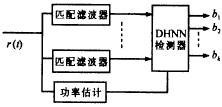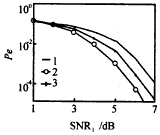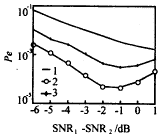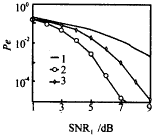A neural network multi-user detector
This paper proposes to use Hopfield neural network to realize the detection of multi-user signals in CDMA multi-user communication system. Using the correspondence between the likelihood function of the best multi-user detector based on the maximum posterior probability of the detection sequence and the energy function of Hopfield neural network, construct a A discrete Hopfield neural network multi-user detector. The research results show that this multi-user detector has excellent performance, its computational complexity is lower than the best multi-user detector, the ability to suppress multi-access interference and overcome the near-far effect is greatly superior For traditional detectors.
Keywords: CDMA; multi-user detection; Hopfield neural network
A Neural Network MulTIuser Detector
JI Xiang, ZHONG Yi-xin
(Beijing University of Posts and TelecommounicaTIons, Beijing 100876, China)
Abstract: A new Hopfield Neural Network mulTIuser detector is proposed.According to the corresponding relaTIon between the power function of Hopfield neural network and the likelihood function of maximum posterior detective probability for optimum multiuser detector, a discrete Hopfield neural network multiuser, detector is constructed. It is shown that the detector complexity is lower than that of optimal detector, and precedes conventional detector in eliminating multi-user interference and near-far resistance.
Key words: CDMA; muti-user detection; Hopfield neural network
1. Introduction In a CDMA communication system, multiple independent users simultaneously share the same frequency spectrum according to different spreading code sequences. Because the cross-correlation of each user is not zero, there is multiple access interference. The traditional single user detection method will User interference is treated as white noise, and its performance is poor. The multi-user detector makes full use of the mutual information between users to eliminate multi-access interference and overcome the near-far effect. The best multi-user designed by Verdu [1] Detection has the best detection performance, but its computational complexity increases exponentially with the number of users. To make multi-user detectors practical, people turn their research to near-optimal multi-user detection with near-optimal performance and lower complexity Exploration of the device [2].
The detection of multi-user signals can be attributed to the system optimization problem, and the neural network is very suitable for solving the combined optimization of the system. Aazhang et al. Proposed the construction of a CDMA multi-user detector by the multi-layer neural network of the BP algorithm [3]. A neural network multi-user detector using the radial basis function RBFN. In this paper, a discrete Hopfield neural network is proposed for multi-user signal detection. First, the optimal multi-user detection theory based on the maximum posterior probability is introduced; according to the neural network and The mapping relationship of the likelihood function constructs a discrete Hopfield neural network multi-user detector. Finally, the system's bit error rate and the ability to suppress the near-far effect are studied. Some valuable conclusions are obtained.
Second, the system model considers the synchronous DS-CDAM communication system. Assuming that the number of cell users is K, there is no fading during signal transmission, and the signal received by the receiver is
![]() (1)
(1)
Where bk and wk represent the information and received signal power of the k-th user, respectively; ![]() Is the signal waveform of the k-th user, ck, i is its spreading code, N and W represent the spreading factor; n (t) is Gaussian noise with mean zero and variance σ2, assuming that the user transmits data bits equally Independent of each other, using the maximum posterior probability theory, the best detector detection is to select the following likelihood function as the largest information vector b *
Is the signal waveform of the k-th user, ck, i is its spreading code, N and W represent the spreading factor; n (t) is Gaussian noise with mean zero and variance σ2, assuming that the user transmits data bits equally Independent of each other, using the maximum posterior probability theory, the best detector detection is to select the following likelihood function as the largest information vector b *
![]() (2)
(2)
The user information set is b = (b1, b2, ..., bk), bi∈ {-1,1}; y = (y1, y2, ..., yk) is the sequence of the received signal after passing the matched filter; H∈ Rk * k is the cross-correlation matrix between user signals, and its elements are hij = ∫T0si (t) sj (t) dt.
Third, the discrete Hopfield neural network multi-user detector Hopfield network is a feedback neural network. Due to the introduction of the concept of energy function, the stability of the network operation has a reliable and simple basis. This paper proposes to use discrete Hopfield neural network (DHNN ) The design of multi-user detectors is mainly based on the following reasons: first, it can quickly obtain stable solutions when solving combinatorial optimization problems. Second, multi-user signal detection can be reduced to a system of combinatorial optimization problems. Finally, discrete neural networks It is easy for large-scale digital integrated chips to implement circuits.
The discrete Hopfield network consists of K neurons connected to each other. Each neuron has a threshold threshold; there are two states {-1, 1} on each node. The transfer characteristic of each node is a sign function. The input of the network Is x = (x1, x2, ..., xK); the output is z = (z1, z2, ..., zK); the state of the network at time t is v (t) = (v1 (t), v2 (t), …, VK (t)); Wij is the connection weight coefficient value of neuron i to neuron j. The Hopfield network is generally symmetrical and the self-feedback weight is zero. When a set of data is input to the network, the network starts Run and get a set of outputs. Then, a set of output status feedback is weighted to each node as the next input of the network, and the next output can be obtained after the threshold decision. The network operation process is the repetition of the above process. If the network can Stable, after repeated operation many times, the network state change gradually decreases, the energy function composed of each state gradually converges, and finally reaches stability. At this time, the output of the detector can be obtained. The entire operation process is described as follows
vi (0) = xi ![]() (3)
(3)
Because the likelihood function of the optimal multi-user detector is very similar to the energy function of the Hopfield network. And the cross-correlation matrix H is a symmetric matrix (hij = hji). As long as the linear transformation of equation (2), there are:
![]() (4)
(4)
Where E is the identity matrix. Since bTEb is positive definite. The matrix (HE) is symmetric and the diagonal elements are zero.
In this way, the likelihood function of the optimal multi-user detector is converted into the energy function of the discrete HNN, whose weight is W = HE, and the input bias θ = Y. Thus, the discrete HNN multi-user detector is obtained, as shown in FIG. 1 Assuming that the signal power of each user can be accurately estimated, the input of the detector is the output of the matched filter. The weight of the HNN is set by the cross-correlation between each user. After multiple feedback operations, the network converges to a stable state. The output of the detector is the final stable value of HNN. The biggest advantage of the DHNN detector over other near-optimal detectors is that it has a fast calculation speed and is easy to implement.

Figure 1 Discrete Hopfield NN multi-user detector structure 4. Performance simulation of DHNN detector Below, a computer simulation of CDMA communication system is used to analyze the performance of DHNN detector. To facilitate implementation, the error code uses asynchronously updated DHNN to construct a multi-user detector. For a two-user system, the spreading gain is assumed to be 3. The cross-correlation coefficient is 1/3, SNR1 = 6dB. In this paper, the error characteristic curve of user 1 is calculated when the power of two users is equal; and the characteristic curve of user 1 when the power of two users changes, as shown in Figure 2 and Figure 3. In the figure, curve 1 represents the performance of the traditional detector, curve 2 represents the best detector error performance, and curve 3 represents the performance of the DHNN detector. Let's examine the CDMA system consisting of four users. Assume that the spreading gain is 7. The cross-correlation coefficient is 1/3, SNR1 = 6dB. When the power of each user is equal, the error characteristic curve of user 1 is calculated; and when the power of user 2 changes, the characteristic curve of user 1 is shown in Figure 4 and figure respectively. 5. |


Figure 2 User 1 SNR and bit error rate | Figure 3 Energy ratio and bit error rate of two users |


Figure 4 User 1 SNR and bit error rate | Figure 5 User energy ratio and bit error rate |
| It can be seen from the above figures that the DHNN detector proposed in this paper has the characteristics of near-optimal multi-user detector, which can effectively suppress multiple access interference and overcome the near-far effect. Its performance is better than traditional detectors. In actual calculations, The complexity is much lower than the best multi-user detector. Comparing the two user number simulation systems, we can see that as the number of users increases, the bit error rate of the DHNN detector increases only slightly. V. Conclusion This article starts from the point that the best multi-user detection can be reduced to a combinatorial optimization problem, and according to the perspective that the neural network can solve the combinatorial problem, using the correspondence between the energy function of the Hopfield neural network and the likelihood function of the optimal detector, A DHNN multi-user detector based on asynchronous update is constructed. Because the state of the neural network in this receiver is convergent. The state of the network can eventually be stabilized on the user data sequence with a large likelihood function. The simulation results show that This DHNN multi-user detector has good detection performance, has the ability to suppress multiple access interference and resist the near-far effect. The calculation complexity is much lower than the best multi-user detector. About the author: Ji Xiang, graduated from Xidian University in 1983 with a bachelor's degree; 1992 received a master's degree in engineering from Xidian University; graduated from Beijing University of Posts and Telecommunications in 1998 with a doctorate in engineering. Mainly interested in digital communications, mobile communications , The application of neural networks, etc. |
DIY Drone landing Gear, Carbon Fiber Landing Gear For Drone, Multi Rotor Landing Gear,Electric Retractable Landing Gear
DIY Drone landing Gear, Carbon Fiber Landing Gear For Drone, Multi Rotor Landing Gear
shenzhen GC Electronics Co.,Ltd. , https://www.jmrdrone.com